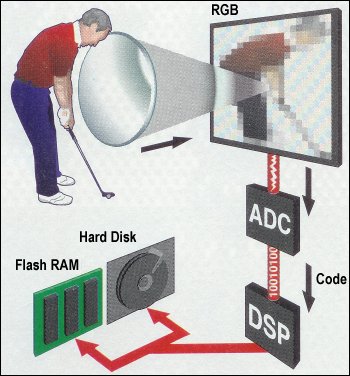DIGITAL CAMERAS
It's easy to understand the booming business that digital camera manufacturers are doing these days. The host of easy-to-use personal and business publishing applications, the dramatic expansion of the Web and its insatiable appetite for visual images, and the proliferation of inexpensive printers capable of photo-realistic output make a digital camera an enticing add-on. Those factors, combined with improving image quality and falling prices, put the digital camera on the cusp of becoming a standard peripheral for a home or business PC.
In principal, a digital camera is similar to a traditional film-based camera. There's a viewfinder to aim it, a lens to focus the image onto a light-sensitive device, some means by which several images can be stored and removed for later use, and the whole lot is fitted into a box. In a conventional camera, light-sensitive film captures images and is used to store them after chemical development. Digital photography uses a combination of advanced image sensor technology and memory storage, which allows images to be captured in a digital format that is available instantly - with no need for a "development" process.

Although the principle may be the same as a film camera, the inner workings of a digital camera are quite different, the imaging being performed either by a charge coupled device (CCD) orCMOS (complementary metal-oxide semiconductor) sensors. Each sensor element converts light into a voltage proportional to the brightness which is passed into an analogue-to-digital converter (ADC) which translates the fluctuations of the CCD into discrete binary code. The digital output of the ADC is sent to a digital signal processor (DSP) which adjusts contrast and detail, and compresses the image before sending it to the storage medium. The brighter the light, the higher the voltage and the brighter the resulting computer pixel. The more elements, the higher the resolution, and the greater the detail that can be captured.
This entire process is very environment-friendly. The CCD or CMOS sensors are fixed in place and it can go on taking photos for the lifetime of the camera. There's no need to wind film between two spools either, which helps minimise the number of moving parts.

No comments:
Post a Comment